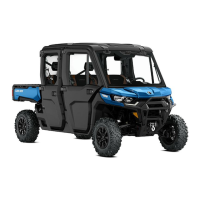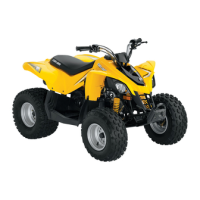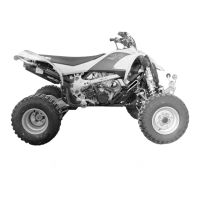RIDING YOUR VEHICLE
Practice Exercises
Before you go out for a ride, it i s very
important to familiarize yourself with
thehandlingofyourvehiclebyprac-
ticing in a controlled environment. If
possible, it is als o a very good idea to
take a m ore formal traini ng cou rse to
sharpen your skills and increase your
knowledge of the v ehicle.
Find a suitabl e area to practice and
perform the following ex erc ises. It
should be at least 45 m (15 0 ft) by 45 m
(150 ft) free of obstacles like trees and
rocks. Once you’ve s elected a suitable
permitted location, proceed with the
following exerc ises.
Turning Exercises
Turning is one of the most frequent
causes of accidents. It is easi er for the
vehicle to lose traction or rollover if you
turn too sharply, or go too fast. Slow
down when you a pproa c h a turn.
– First learn ho w to perform slight
right turns at very low speeds. Re-
lease the throttle be fore turning a nd
slowly rea pply the throttle when
turning.
– R epea t turni ng e xe rcise but this
time maintain the throttle at the
level while turning.
– Final ly, repea t turning exercise
while accelerating slowly.
– Practice exercises turning on the
other side .
Note how your vehi cle reacts in these
different exercises. We recommend
releasing the throttle before entering a
turn to help initiate directional cha nge.
You will feel the lateral force increasing
with the speed and with your steer-
ing input. The lateral force should be
maintained as l ow as possible to make
sure it does no t cause the vehicle to
roll over.
U Turn Exercises
Practice doin g U turns.
– Accelerate slowly and while remain-
ing at low speed , then gradually turn
the s teering wheel to the right until
you have completed the U turn.
– Repea t U turn exercise with differ-
ent steering inpu ts and a lw ays a t a
very low sp eed.
– R epea t U turn e xe rcise on the other
side.
As mentioned before in this guide, do
not ride on pa v ed surfaces as the v e-
hicle behavior will not be the same,
increasing the risk of rollover.
Braking Exercises
Practice braking to get familiar with the
brake respons e.
– Do it at low speed first, then in-
crease the speed.
– Practice braking in straight line at dif-
ferent speeds and different braking
force.
– Practice emergency braking; opti-
mal braking i s obtained in straight
line, with high force a ppli ed, with-
out locking the wheels.
Remember, braking distance dep ends
on vehicle speed, load and the type of
surface. Also, the tires and brakes con-
ditionsplayamajorrole.
Reverse Exercises
The next step involves using the re-
verse.
– Install1conemarkeronbothsides
of the vehicle besi de each rea r
wheel. Mov e the ve hicle forward
until you can see the cone markers,
then stop the vehicle. Ac k nowl-
edge the distanc e required to s ee
obstacles behind you.
– Learn ho w the v ehicle handles its elf
in reverse and reacts with steeri ng
inputs.
– Alw ays perform th is reverse exer-
cise at slow speeds .
________
SAFETY INFOR MAT ION
________
21

